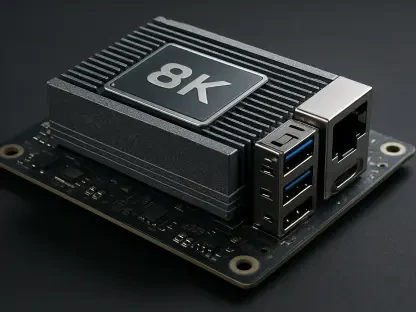AI has the potential to revolutionize wireless networks by introducing common sense reasoning and smarter decision-making capabilities. As the transition from 5G to 6G approaches, integrating advanced AI can address current limitations and usher in a new epoch of intelligent networking. This innovative blueprint is proposed by Professor Walid Saad and his colleagues at the Virginia Tech Innovation Campus, who have meticulously analyzed the integration of human-like AI into next-generation wireless systems.
The Need for Evolution in Wireless Networks
Current Limitations of AI in Wireless Networks
Despite numerous advancements in AI and wireless technology, present-day AI systems are constrained by their reliance on statistical data, resulting in limited capacity to handle unforeseen scenarios. This limitation impedes the development of truly intelligent wireless networks, as these systems struggle to respond adequately to novel situations unsupported by known patterns. The current AI mechanisms are adept at identifying statistical correlations and trends but falter when it comes to reasoning beyond the initial data scope.
By solely focusing on pattern recognition without incorporating a broader understanding of context or common sense reasoning, existing AI falls short of achieving the nuanced decision-making and adaptability observed in human intelligence. Consequently, this shortcoming restricts wireless networks from tapping into AI’s full potential, hindering innovation and progress in providing more intelligent networking solutions. Such AI limitations underscore the necessity for advancements that can transcend traditional data-driven models, embracing more holistic approaches to problem-solving and decision-making.
The Leap from 5G to 6G
The evolution from 5G to 6G wireless networks represents a significant technological milestone, promising enhanced performance and broader connectivity. However, this transition alone might be insufficient to address the increasing complexity and diverse demands of future wireless communication. Future systems need more than mere incremental improvements; they require a revolutionary integration of advanced AI designed to think and reason in ways analogous to human cognition. Building networks capable of common sense reasoning will allow them to anticipate and adapt to unpredictable scenarios, elevating the standard of service and reliability.
Traditional advancements in wireless technologies have focused on increasing speed, reducing latency, and expanding bandwidth. While these improvements are vital, they do not fully address the challenges posed by dynamic, real-world environments. Hence, integrating AI with human-like cognitive abilities is critical for moving beyond the limitations of 5G and achieving the true potential of 6G networks. Such an integration promises a paradigm shift, transforming wireless networks into intelligent systems capable of autonomous and adaptive problem-solving, ensuring future communication infrastructures are robust and responsive.
Human-like AI Integration
Incorporating Common Sense in AI
The concept of imbuing AI with human-like common sense stands as a cornerstone for developing intelligent wireless systems. This capability would enable AI to process information, think, plan, and imagine solutions for addressing new and complex scenarios effectively. By incorporating common sense, AI systems can interpret context and nuances that transcend mere data correlations, facilitating more sophisticated decision-making processes. AI endowed with common sense goes beyond pattern recognition to grasp the underlying principles governing various situations, much like human cognition.
To achieve this, AI must be programmed to understand and replicate intuitive reasoning, which is naturally present in human thought processes. This includes recognizing physical limitations, environmental constraints, and user expectations, thereby making AI systems more reliable and interactive. With common sense integration, AI can enhance its ability to generalize knowledge and apply learned principles to novel circumstances, improving the adaptability of wireless networks. Such advancements bridge the gap between theoretical AI models and practical applications, propelling wireless networks into a realm of true intelligence and versatility.
Building Adaptive and Trustworthy Networks
Empowering AI with common sense reasoning can lead to the creation of wireless networks that are not only more adaptable but also trustworthy. Networks designed with advanced AI capabilities can explain their decision-making processes, bolstering user confidence and transparency. An AI system capable of articulating the rationale behind its actions enhances the trustworthiness of the network, ensuring users can rely on consistent and logical behavior under various conditions. This transparency is critical for promoting widespread adoption and fostering user trust in future wireless technologies.
Moreover, adaptability goes hand in hand with trustworthiness. Common sense AI equips networks to respond dynamically to unexpected situations, adjusting operations to maintain optimal performance levels and service standards. An adaptable network can maximize efficiency and reliability by preemptively identifying potential disruptions and offering timely solutions. These networks combine the flexibility of human reasoning with the systematic rigor of artificial intelligence, establishing a new benchmark in wireless communication. Ultimately, this transformation promises a future where networks can self-regulate, optimize resources, and seamlessly meet growing and evolving user demands.
Convergence of Physical, Virtual, and Digital Worlds
Seamless Interactions Across Domains
Future wireless networks must facilitate seamless interactions across the physical, virtual, and digital realms. This integration requires both state-of-the-art wireless technologies and AI systems adept at orchestrating these interactions efficiently and intelligently. By ensuring smooth interconnectivity between different domains, networks can provide enriched user experiences and innovative applications that traverse boundaries traditionally separating these realms. This convergence is pivotal for creating ecosystems wherein users can effortlessly transition between physical and virtual spaces, driven by augmented AI capabilities.
Incorporating AI to manage these interactions involves multifaceted approaches, including real-time analysis, predictive modeling, and adaptive response mechanisms. AI systems should be able to comprehend the context within each domain and navigate the complexities involved in maintaining uninterrupted functionality. By managing the intricate interplay between physical infrastructure, virtual content, and digital data, AI can help deliver synergetic solutions that advance seamless integration. This holistic approach underlines the importance of AI as a central component in bridging disparate aspects of future wireless networks, contributing to a unified and immersive user experience.
Quality Service Requirements
Achieving seamless integration across domains necessitates maintaining exceptionally high-quality service standards in wireless networks. Advanced AI systems with common-sense reasoning capabilities can play a crucial role in meeting these demands by ensuring smooth command over all aspects of network operations. Quality service in this context involves reliability, robustness, and the ability to scale service provision effortlessly in response to dynamic user needs and environmental changes. AI’s common-sense reasoning aids in proactively addressing issues before they escalate, ensuring uninterrupted and high-caliber service delivery.
Moreover, maintaining high-quality service standards goes beyond mere technical enhancements and encompasses intuitive and user-centric approaches. AI must be able to understand user behaviors, predict needs, and adapt service offerings accordingly. This level of interaction centers around fostering user satisfaction and trust, key drivers for the widespread acceptance of advanced wireless technologies. By embedding common sense within AI systems, networks can offer superior and personalized user experiences, demonstrating enhanced resilience and responsiveness in various operational contexts and scenarios.
The Role of Metaverse and Digital Twins
Real-time Perception and Cognitive Abilities
The integration of metaverse and digital twins in wireless networks is pivotal for providing AI with real-time perception and cognitive abilities. These technologies can mirror the physical world, enabling AI to acquire nuanced understanding and common-sense reasoning crucial for next-gen networks. Digital twins simulate real-world entities and systems, offering a dynamic and interactive framework for AI to process and analyze complex data in real-time. This approach allows AI to develop cognitive abilities analogous to human intuition, significantly enhancing its decision-making and problem-solving capabilities.
Incorporating metaverse technologies further extends this capability by creating immersive virtual environments where AI can engage, experiment, and learn from simulated scenarios. These environments facilitate AI’s ability to interpret and predict outcomes in a controlled yet flexible space, fostering deeper comprehension of both virtual and physical interactions. Real-time perception empowers AI to anticipate challenges, innovate solutions, and adapt to fluctuating conditions with high precision. This fusion of digital twins and metaverse technologies epitomizes the transformative potential of AI in advancing the robustness and intelligence of wireless networks.
Creating the ‘Telecom Brain’
Leveraging digital twins and the metaverse can make feasible the creation of a ‘telecom brain’—a network capable of understanding and planning beyond its initial training data, akin to human intelligence. The concept of a telecom brain involves developing AI systems that can autonomously manage and optimize network operations by interpreting vast and complex data sets intuitively. These systems would possess the ability to make strategic decisions, foresee potential disruptions, and implement proactive measures to ensure seamless network performance.
The telecom brain represents the culmination of integrating advanced AI with immersive technologies, providing a network with cognitive capabilities that mirror human strategic thinking and planning. Digital twins contribute to this vision by offering expansive datasets for AI to analyze and learn from, enhancing its ability to predict and problem-solve with accuracy. Meanwhile, the metaverse facilitates experimental learning, enabling AI to refine its cognitive processes through simulated interactions. This confluence of technologies signifies a profound shift towards creating intelligent, adaptive, and self-regulating wireless networks that embody an advanced form of artificial general intelligence.
An Interdisciplinary Approach
Blending Insights from Multiple Fields
Developing AI-native networks necessitates an interdisciplinary approach, blending insights from various fields such as mathematics, neuroscience, and wireless technology. By integrating principles from diverse domains, researchers can create a holistic and advanced AI system capable of reasoning and understanding. Mathematics offers tools for structuring and analyzing complex data, while neuroscience provides insights into cognitive processes, critical for emulating human-like intelligence. Wireless technology encompasses the technical infrastructure required to implement these sophisticated AI systems effectively.
This interdisciplinary collaboration ensures the development of AI systems that embody robust analytical capabilities and intuitive reasoning, akin to human cognition. Each field contributes unique perspectives and methodologies, enriching the AI development process and ensuring comprehensive solutions that address multifaceted challenges. The synergy among these disciplines leads to innovations that not only enhance the intelligence of wireless networks but also improve their adaptability and reliability. This holistic approach is instrumental in overcoming the limitations of traditional AI models and fostering forward-thinking solutions that revolutionize wireless communication.
Future Prospects
AI has the potential to transform wireless networks by incorporating common sense reasoning and improving decision-making capabilities. As we move towards the transition from 5G to 6G, integrating advanced AI technologies can tackle present limitations and lead to a new era of intelligent networking. This visionary framework is presented by Professor Walid Saad and his team at the Virginia Tech Innovation Campus, who have thoroughly examined the fusion of human-like AI concepts with next-generation wireless systems. They believe that AI can offer solutions to current network challenges such as bandwidth efficiency, signal optimization, and user experience enhancement. By bringing human-like intelligence to these systems, it is possible to achieve more dynamic and responsive wireless networks, paving the way for unprecedented technological advancements. This initiative also aims to provide a foundation for future research and development in the field, ensuring that wireless communication continues to evolve and adapt to the ever-growing demands of modern society.









